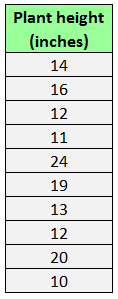A boxplot (sometimes called a box-and-whisker plot) is a plot that shows the five-number summary of a dataset.
The five-number summary include:
- The minimum
- The first quartile
- The median
- The third quartile
- The maximum
A boxplot allows us to easily visualize the distribution of values in a dataset using one simple plot.
How to Make a Boxplot
To make a boxplot, we draw a box from the first to the third quartile. Then we draw a vertical line at the median. Lastly, we draw “whiskers” from the quartiles to the minimum and maximum value.
Suppose we have the following dataset that shows the height of ten plants:

To make a boxplot, we need to find the minimum, first quartile, median, third quartile, and maximum.
Step 1: Arrange the data from smallest to largest.
10, 11, 12, 12, 13, 14, 16, 19, 20, 24
Step 2: Find the median.
In this case, it’s the average of the middle two numbers:
10, 11, 12, 12, 13, 14, 16, 19, 20, 24
Median = (13 + 14) / 2 = 13.5
Step 3: Find the lower quartile (Q1) and upper quartile (Q3).
The lower quartile is the median of the numbers to the left of the median. In this case, it’s 12.
10, 11, 12, 12, 13, 14, 16, 19, 20, 24
The upper quartile is the median of the numbers to the right of the median. In this case, it’s 19.
10, 11, 12, 12, 13, 14, 16, 19, 20, 24
Step 4: Find the minimum and maximum values.
The minimum is 10 and the maximum is 24.
10, 11, 12, 12, 13, 14, 16, 19, 20, 24
Step 5: Draw the boxplot using our five number summary.
Why Are Boxplots Useful?
Boxplots are useful because they help us visualize five important descriptive statistics of a dataset: the minimum, lower quartile, median, upper quartile, and maximum.
Boxplots also help us easily answer questions like:
What is the median height of the plants?
To answer this, we can look for the vertical line within the box that indicates the median. In this case, it’s 13.5 inches.
How tall is the tallest plant?
To answer this, we can look for the dot at the end of the right whisker that indicates the maximum. In this case, it’s 24 inches.
What percent of plants are taller than 19 inches?
To answer this, we can see that the the upper quartile (Q3) is equal to 19. Recall that the upper quartile represents the 75th percentile, which means 75% of values are equal to or less than 19.
This means that 25% of values are greater than 19. So, 25% of plants are taller than 19 inches.
How to Create Boxplots Using Different Software
The following tutorials provide step-by-step examples of how to create boxplots using different software:
How to Make Box Plots in Excel
How to Make a Box Plot in Google Sheets
How to Make Box Plots in SPSS
How to Make Box Plots in Stata
Online Box Plot Generator




